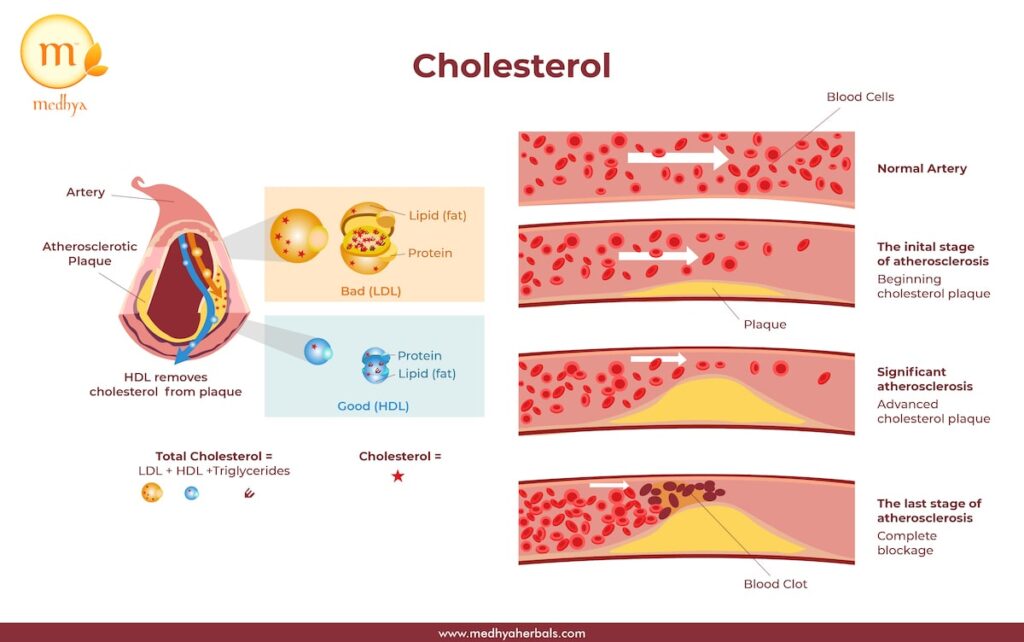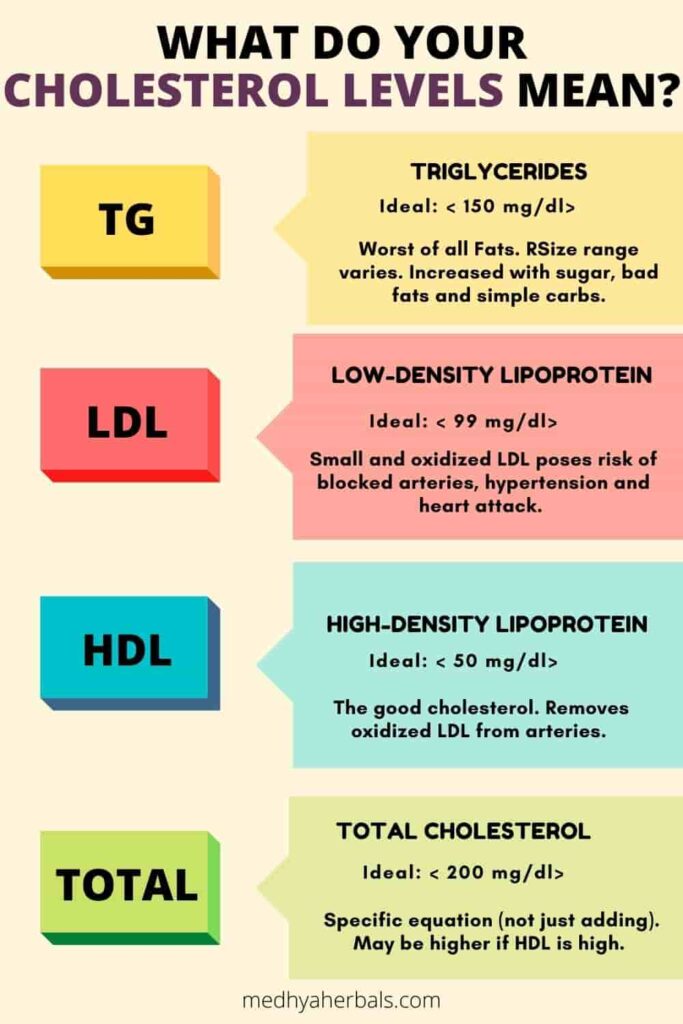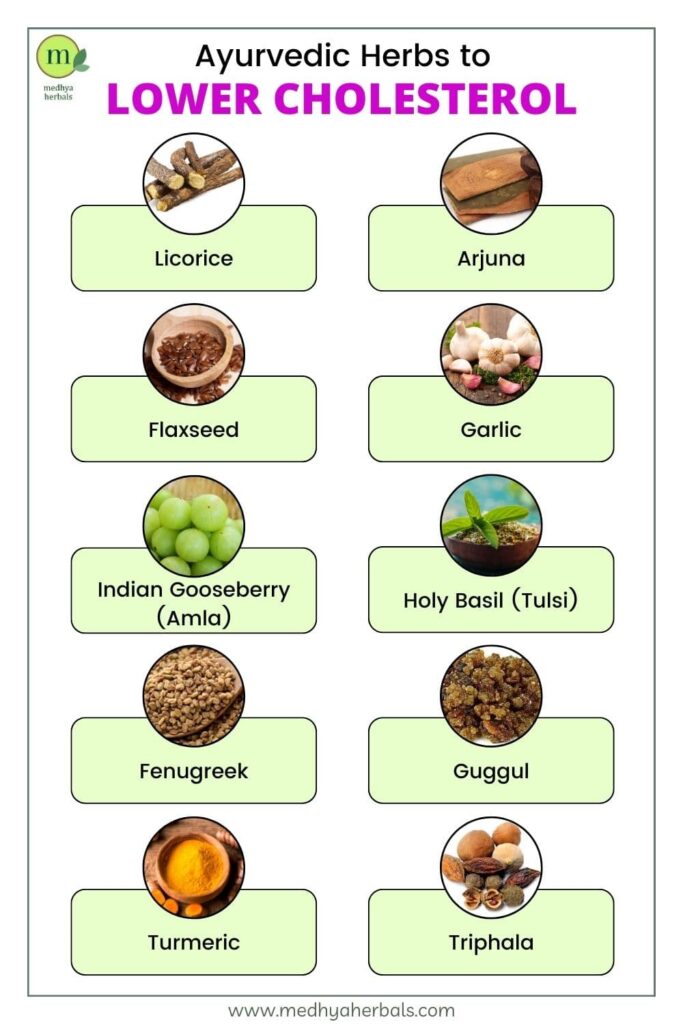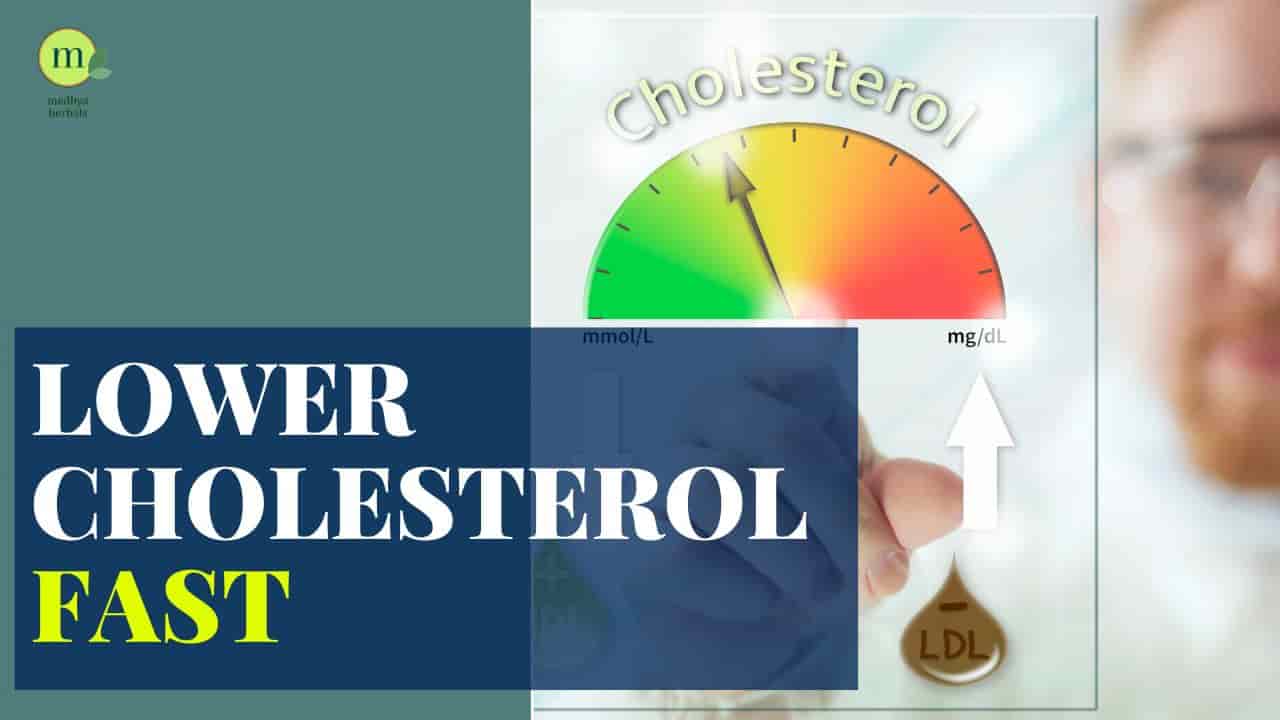Cholesterol, a waxy substance found in your blood, plays a vital role in the creation of cell membranes, certain hormones, and vitamin D. Yet, when it reaches high levels, it can become a silent threat to your health, potentially leading to severe conditions like heart disease and stroke. Approximately 93 million U.S. adults, or nearly 40% of the population, have high cholesterol, according to the Centers for Disease Control and Prevention.
As an experienced Ayurvedic doctor, specializing in women’s health, I have seen the transformative power of natural, holistic approaches in managing health conditions. While high cholesterol levels might be widespread, this doesn’t mean they’re inevitable. In fact, you can significantly lower cholesterol levels naturally and quickly, sometimes seeing improvements in as little as 7 to 30 days. This article will provide you with an in-depth look at the science and the natural, Ayurvedic ways to lower your cholesterol fast.
Over the years, I’ve helped countless clients improve their cholesterol profiles by using time-honored techniques and dietary changes. We will delve into the role of specific superfoods, exercises, and lifestyle modifications in cholesterol management. We’ll also uncover the worst foods for high cholesterol and present strategies to lower your cholesterol with diet, offering you a blueprint for a healthier, more balanced life.
Whether you’re looking for how to lower cholesterol levels, reduce them in a month, or want to understand the role of your diet in maintaining these levels, we’ve got you covered. Get ready to embark on a journey towards better health, armed with knowledge and actionable insights. Your path to lower cholesterol naturally starts here.
Understanding Cholesterol
Cholesterol is a waxy, fat-like substance that’s found in all the cells in your body. It’s used to produce hormones, vitamin D, and substances that help you digest foods. Your body makes all the cholesterol it needs, but cholesterol is also found in some of the foods you eat.

There are two main types of cholesterol:
- LDL (Low-Density Lipoprotein) often referred to as “bad” cholesterol, contributes to fatty buildups in arteries. This can lead to heart disease and stroke.
- HDL (High-Density Lipoprotein) often referred to as “good” cholesterol, carries cholesterol from other parts of your body back to your liver, where it’s removed from your body.
A high level of LDL cholesterol leads to a buildup of cholesterol in your arteries, while high levels of HDL cholesterol are associated with a lower risk of heart disease.
Causes of High Cholesterol
High cholesterol can be inherited, but it’s often the result of unhealthy lifestyle choices, making it preventable and treatable.
- Diet: Eating saturated fat, found in animal products, and trans fats, found in some commercially baked cookies and crackers, can raise your cholesterol level.
- Obesity: Having a body mass index (BMI) of 30 or greater puts you at risk of high cholesterol.
- Lack of Exercise: Exercise helps boost your body’s HDL, the “good” cholesterol, while increasing the size of the particles that make up your LDL, or “bad” cholesterol, which makes it less harmful.
- Smoking: Cigarette smoking damages the walls of your blood vessels, making them more prone to accumulate fatty deposits. Smoking might also lower your level of HDL, or “good” cholesterol.
- Age: As you age, your liver becomes less able to remove LDL cholesterol.
- Diabetes: High blood sugar contributes to higher levels of a dangerous cholesterol called very-low-density lipoprotein (VLDL) and lower HDL cholesterol. High blood sugar also damages the lining of your arteries
What should be the normal cholesterol levels?

Cholesterol levels are measured in milligrams per deciliter of blood (mg/dL). The American Heart Association provides the following guidelines for cholesterol levels in adults:
- Total Cholesterol
- Desirable: Less than 200 mg/dL
- Borderline High: 200-239 mg/dL
- High: 240 mg/dL and above
- LDL Cholesterol (often referred to as “bad” cholesterol)
- Optimal: Less than 100 mg/dL
- Near Optimal: 100-129 mg/dL
- Borderline High: 130-159 mg/dL
- High: 160-189 mg/dL
- Very High: 190 mg/dL and above
- HDL Cholesterol (often referred to as “good” cholesterol)
- Major Heart Disease Risk: Less than 40 mg/dL for men and less than 50 mg/dL for women
- The Higher, the Better: 60 mg/dL and above offers some protection against heart disease
- Triglycerides
- Normal: Less than 150 mg/dL
- Borderline High: 150-199 mg/dL
- High: 200-499 mg/dL
- Very High: 500 mg/dL or above
Please remember that these are general guidelines, and what’s considered “normal” can vary depending on your overall health, age, gender, and other factors. Always consult with a healthcare provider for personalized advice on your cholesterol levels. Regular monitoring is essential to ensure that your cholesterol levels stay within healthy ranges.
Early Warning Signs of High Cholesterol
Cholesterol is a fatty substance that’s vital to many bodily functions. However, when you have too much ‘bad’ cholesterol (LDL), it can build up in your arteries and lead to heart disease. Unfortunately, high cholesterol usually doesn’t have noticeable symptoms until serious problems occur. This is why it’s often called the “silent killer.”
However, certain signs and symptoms might indirectly indicate high cholesterol levels due to the conditions associated with it, such as atherosclerosis (hardening of the arteries), heart disease, and stroke.
Chest Pain (Angina)
One of the most common signs of high cholesterol is chest pain or discomfort, known as angina. It happens when the cholesterol buildup in your arteries prevents enough oxygen-rich blood from reaching your heart.
Heart Attack or Stroke
A sudden heart attack or stroke could be the first sign of high cholesterol for some people. These can occur if a piece of the cholesterol plaque in your arteries breaks off and causes a blockage in the heart or brain.
Pain While Walking
If cholesterol has built up in the arteries in your legs (peripheral artery disease), you may experience pain, heaviness, or weakness in your legs while walking or exercising.
High Blood Pressure
While high cholesterol doesn’t cause high blood pressure, the two conditions often go hand in hand, possibly due to similar risk factors like poor diet and lack of exercise.
Yellow Patches on Skin
In rare cases, high cholesterol can lead to visible changes on your body. One such sign is the development of yellowish, fatty bumps called xanthomas, usually on the elbows, knees, or buttocks.
Diagnosis and Check for Cholesterol
People who have pain in the chest, heart attack, stroke or feel uncomfortable during walking should test their blood to know their LDL level.
The frequency of measuring the level depends on one’s age, risk factors, and family history. Here are general recommendations for testing LDL level.
For people aged 19 or younger:
- Initially, the test should be done between ages 9 to 11
- The test should be done following every 5 years
- If there is a family history of high blood LDL levels, heart attack, or stroke, children should have a test starting at age 2.
For people aged 20 or more:
- Younger adults may test their LDL in every 5 years
- Men, whose ages in between 45 and 65 and women, in between 55 to 65 should go for a test in every 1 to 2 years,
Natural Ways to Lower Your Cholesterol Fast: An Ayurvedic Approach
When we talk about lowering cholesterol “fast,” it’s essential to note that the speed at which cholesterol levels decrease can vary greatly from person to person. “Fast” in this context does not necessarily mean overnight or within a few days. Significant changes in cholesterol levels often take weeks or even months, but with consistent effort and lifestyle modifications, noticeable improvements can be achieved in a relatively short period of time, such as a month. Ayurveda, a holistic system of medicine, offers a holistic approach to manage high cholesterol, including diet modifications, lifestyle changes, and natural herbs.
1. Best Ayurvedic Herbs and Supplements for Lowering Cholesterol

Ayurveda, an ancient system of medicine, offers a variety of herbs and supplements that can be used in the management of high cholesterol. These natural remedies work synergistically with diet and lifestyle changes to improve heart health.
Garlic (Allium Sativum)
Garlic is renowned for its cholesterol-lowering properties. The allicin found in garlic prevents the liver from producing too much cholesterol and aids in reducing the hardening of arteries.
Turmeric (Curcuma Longa)
The active compound in turmeric, curcumin, has potent anti-inflammatory and antioxidant properties. It helps in reducing LDL cholesterol and preventing plaque build-up in the arteries.
Ginger (Zingiber Officinale)
Ginger is a versatile herb that helps reduce cholesterol and blood triglyceride levels. It also improves blood circulation and reduces the risk of heart diseases.
Fenugreek (Trigonella Foenum-Graecum)
Fenugreek seeds are rich in fiber, which helps in lowering LDL cholesterol. They also contain compounds like saponins that help reduce the absorption of cholesterol.
Guggul (Commiphora Mukul)
Guggul is a traditional Ayurvedic remedy for high cholesterol. Its active compounds, guggulsterones, help lower LDL cholesterol and triglycerides, improving overall heart health.
Green Tea
Green tea is praised for its abundant health benefits, including its potential to lower cholesterol levels. It is rich in antioxidants called catechins, which have been shown to reduce LDL cholesterol levels and increase HDL cholesterol. Incorporating a few cups of green tea into your daily routine can be an easy and beneficial change.
Remember, while these herbs and supplements can be effective, they are not substitutes for a balanced diet and regular exercise. Always consult with a healthcare provider or an Ayurvedic practitioner before starting any new supplement regimen, as these herbs can interact with certain medications.
2. Cholesterol Lowering Foods
Ayurvedic principles place immense emphasis on diet as a primary way to manage health conditions. Consuming a balanced diet rich in fruits, vegetables, whole grains, lean proteins, and healthy fats can aid in reducing cholesterol levels. Additionally, certain Ayurvedic herbs and spices, such as garlic and ginger can boost heart health, lower LDL (bad) cholesterol, and increase HDL (good) cholesterol.
Oats and Whole Grains
Rich in soluble fiber, oats and whole grains can reduce the absorption of cholesterol into your bloodstream. Foods like oatmeal, brown rice, and whole grain bread are excellent choices.
Fatty Fish
Fatty fish like salmon, mackerel, and albacore tuna are packed with omega-3 fatty acids, which can lower LDL cholesterol and raise HDL cholesterol.
Nuts and Seeds
Almonds, walnuts, and flaxseeds are high in monounsaturated fats, which can help lower LDL cholesterol. They also contain sterols, which reduce the absorption of cholesterol.
Avocados
Avocados are an excellent source of monounsaturated fats, which can lower LDL cholesterol and raise HDL cholesterol. They are also rich in fiber and antioxidants.
Fruits and Vegetables
Fruits and vegetables are high in fiber, low in saturated fat, and rich in cholesterol-lowering antioxidants. Opt for a variety like apples, berries, oranges, bell peppers, carrots, and leafy greens.
Adding these foods to your diet can significantly help lower your cholesterol levels and improve heart health. Remember, a balanced diet should be complemented with regular exercise and a healthy lifestyle for best results. Always consult with a healthcare provider or a nutritionist for personalized advice.
3. The Worst Foods for High Cholesterol: What to Avoid for Healthier Lipid Levels
When managing high cholesterol, knowing what to avoid can be just as important as knowing what to eat. Certain foods can contribute to increased levels of LDL (bad) cholesterol, leading to a greater risk of heart disease and stroke.
Trans Fats
Trans fats, also known as partially hydrogenated oils, are one of the worst culprits for high cholesterol. They raise LDL cholesterol, lower HDL (good) cholesterol, and increase the risk of heart disease. These are often found in fried foods, baked goods, and certain margarines.
Saturated Fats
Saturated fats, found in red meat and full-fat dairy products, can raise your total cholesterol. These foods also contain dietary cholesterol, which can further increase cholesterol levels for some people.
Processed Meats
Processed meats such as sausages, bacon, and hot dogs are high in cholesterol and saturated fats. Consuming these regularly can lead to increased cholesterol levels and other health risks.
Foods with Added Sugars
Foods and drinks with added sugars, like soda, candy, and certain cereals, can contribute to weight gain, which can indirectly increase cholesterol levels.
Certain Seafood
While seafood can be a great source of lean protein and omega-3 fatty acids, certain types like shrimp are high in dietary cholesterol. They may raise blood cholesterol levels in some individuals, especially when consumed in large quantities.
By understanding which foods can negatively impact your cholesterol levels, you can make healthier choices that contribute to better heart health. Remember, balance is key – occasional indulgences can fit into a heart-healthy diet, but it’s important to limit these high-cholesterol foods overall. Always consult with a healthcare provider or a nutritionist for personalized advice.

4. Healthy Lifestyle for Optimal Cholesterol Levels
Maintaining a healthy lifestyle is key to achieving and maintaining optimal cholesterol levels. It’s not just about what you eat; it’s also about how you live. Here are some lifestyle changes that can help.
Regular Exercise
Regular physical activity increases HDL (good) cholesterol while lowering LDL (bad) cholesterol and triglycerides. Aim for at least 30 minutes of moderate-intensity exercise, like brisk walking or cycling, most days of the week.
Healthy Eating
Consume a heart-healthy diet rich in fruits, vegetables, whole grains, lean proteins, and healthy fats. Limit intake of saturated fats, trans fats, and cholesterol-rich foods.
Weight Management
Maintaining a healthy weight can help lower cholesterol levels. Even a small weight loss can have a significant impact on your cholesterol.
Smoking Cessation
If you smoke, quit. Smoking lowers HDL cholesterol, increases LDL cholesterol, and damages your blood vessels, making them more prone to accumulate fatty deposits.
Moderate Alcohol Use
If you drink alcohol, do so in moderation. Moderate drinking has been associated with higher levels of HDL cholesterol, but the benefits aren’t strong enough to recommend alcohol for anyone who doesn’t already drink.
Stress Management
Chronic stress can indirectly affect your cholesterol levels by influencing your habits. Techniques for managing stress, such as meditation, yoga, and deep breathing, can help you stay healthy.
Adopting a healthy lifestyle can have a profound impact on your overall health and well-being, including your cholesterol levels. Remember, every step towards a healthier lifestyle counts, so start where you are and make progress at your own pace.
5. Yoga for Lowering Cholesterol Naturally
Yoga is an ancient practice that promotes physical, mental, and spiritual health. It can also be a natural and effective way to help lower cholesterol levels. Here’s how:
Improved Blood Circulation
Many yoga postures enhance blood circulation, particularly in the abdominal region, which can help improve the efficiency of the liver, where cholesterol is processed.
Stress Management
Yoga’s emphasis on mindfulness and relaxation can help reduce stress, a significant factor that can indirectly lead to high cholesterol levels.
Weight Management
Yoga can contribute to weight loss and maintenance, which is beneficial since being overweight or obese can increase your cholesterol levels.
Here are a few yoga poses that are especially beneficial for heart health and cholesterol levels:
Chakrasana (Wheel Pose)
This pose strengthens the heart muscle and improves blood circulation. It also stimulates the thyroid gland, which plays a role in cholesterol metabolism.
Ardha Matsyendrasana (Half Spinal Twist Pose)
This pose massages the abdominal organs, improves digestion, and enhances liver function, aiding in better processing of cholesterol.
Shalabhasana (Locust Pose)
This pose strengthens the heart muscle and improves blood circulation. It also aids in digestion and helps to regulate metabolism, including that of lipids.
Paschimottanasana (Seated Forward Bend)
This pose stimulates the liver and kidneys, helping to regulate cholesterol levels. It also calms the mind, reducing stress, a known factor in high cholesterol.
Remember, while yoga can be a powerful tool in your cholesterol-lowering regimen, it’s most effective when combined with a balanced diet and other healthy lifestyle choices. If you’re new to yoga, it’s advisable to start under the guidance of a trained instructor.
Conclusion
Managing cholesterol levels and safeguarding your heart health can often feel like a daunting task, especially when you’re facing a myriad of advice, medications, and dietary plans. You may feel overwhelmed, confused, and unsure where to begin. It’s important to remember that it’s completely normal to feel this way. High cholesterol is a widespread concern, and you’re not alone in your journey towards better health.
Ayurveda, a holistic system of medicine, can provide an effective, personalized path to address your cholesterol concerns. Its focus on root cause treatment ensures that you’re not just managing the symptoms but truly resolving the issue from its core. Medhya Herbals’ Ayurvedic Doctors offer this holistic and tailored approach, combining diet, lifestyle modifications, and natural herbs to support your body’s natural healing processes.
In conclusion, taking the first step towards lowering your cholesterol naturally is within your reach. With expert guidance and personalized treatment plans, it’s possible to manage and even reverse high cholesterol levels without solely relying on medication. If you’re ready to take control of your health and begin your journey towards better cholesterol levels and overall wellbeing, schedule a consultation with Medhya Herbals’ Ayurvedic Doctors today. Embrace the power of Ayurveda and discover a healthier, more balanced you.
FAQ
What can I eat for dinner to lower cholesterol?
For a cholesterol-lowering dinner, opt for dishes rich in fiber, lean proteins, and omega-3 fatty acids. Start with a hearty salad made of leafy greens like spinach or kale, topped with avocado and a handful of almonds or walnuts. Your main course could be grilled salmon or mackerel, known for their high omega-3 content, accompanied by quinoa or brown rice. Round out the meal with steamed vegetables like broccoli or Brussels sprouts. For dessert, consider a small bowl of berries or an apple – both high in soluble fiber, which can reduce the absorption of cholesterol into your bloodstream. This balanced, nutrient-dense meal can contribute to lower cholesterol levels over time when incorporated into a consistent, healthy eating pattern.
What is normal cholesterol level?
Normal cholesterol levels can vary slightly depending on the specific guidelines used, but generally, total cholesterol should be below 200 milligrams per deciliter (mg/dL). When it comes to LDL (bad) cholesterol, levels below 100 mg/dL are considered optimal. For HDL (good) cholesterol, higher levels are better, with 60 mg/dL or more being protective against heart disease. Triglycerides, another type of fat in your blood, should ideally be under 150 mg/dL. It’s important to remember that these are general guidelines, and individual targets may vary depending on other health conditions or risk factors. Always consult with your healthcare provider for understanding your personal cholesterol goals.
What is the best herb for high cholesterol?
Garlic is often hailed as the best herb for managing high cholesterol due to its potent medicinal properties. Several studies have shown that garlic can help lower LDL (bad) cholesterol without affecting HDL (good) cholesterol. Its active compound, allicin, is believed to prevent the liver from producing too much cholesterol. Additionally, garlic is rich in antioxidants that promote heart health by reducing blood pressure and slowing down the hardening of the arteries. While more research is needed to understand the optimal dosage, including a moderate amount of garlic in your diet can be a part of a holistic approach to lower cholesterol levels. However, always consult with a healthcare provider before starting any new supplement regimen, as garlic can interact with certain medications.
Does exercise lower cholesterol?
Absolutely, regular exercise is a powerful tool in managing and lowering cholesterol levels. Engaging in physical activity, especially aerobic exercises like walking, running, cycling, or swimming, can help raise your HDL (good) cholesterol while reducing your LDL (bad) cholesterol and triglycerides. Exercise also improves your heart health by lowering blood pressure, reducing body weight, and enhancing the overall fitness of your cardiovascular system. It’s recommended that adults aim for at least 150 minutes of moderate-intensity or 75 minutes of high-intensity exercise per week, but any increase in physical activity can contribute to better cholesterol levels and improved heart health. Always remember, before starting a new exercise regime, it’s best to consult with your healthcare provider to ensure the activities are safe and suitable for your specific needs.
What are 5 foods that can lower cholesterol?
There are numerous foods that can contribute to lower cholesterol levels. Here are five particularly effective ones. First, oats and other whole grains are rich in soluble fiber, which reduces your body’s absorption of cholesterol. Second, fatty fish like salmon and mackerel are high in omega-3 fatty acids, which can lower LDL (bad) cholesterol and boost HDL (good) cholesterol. Third, nuts and seeds such as almonds and flaxseeds not only offer healthy fats but also contain sterols, compounds that block cholesterol absorption. Fourth, avocados are an excellent source of monounsaturated fats, which can lower LDL cholesterol while raising HDL cholesterol. Lastly, fruits and vegetables like apples, citrus fruits, berries, and carrots are rich in fiber and antioxidants, contributing to heart health and lower cholesterol levels.
What are the worst foods for high cholesterol?
Several foods are known to negatively impact your cholesterol levels. These include fatty cuts of meat, which are high in saturated fats and can increase your LDL (bad) cholesterol. Processed meats like sausages, hot dogs, and bacon are also problematic. Full-fat dairy products such as butter, cream, and cheese can elevate cholesterol levels too. Trans fats, found in many fried foods, baked goods, and margarines, are particularly harmful as they raise LDL cholesterol and lower HDL (good) cholesterol. Foods with added sugars, like soda, candies, and certain cereals, can lead to weight gain, which indirectly affects cholesterol levels. Lastly, certain types of seafood, like shrimp, are high in dietary cholesterol. While dietary cholesterol doesn’t affect everyone the same way, some individuals may see a rise in blood cholesterol after consuming it.
How can I lower my cholesterol without medication?
Lowering cholesterol without medication involves adopting healthy lifestyle changes. Regular physical activity, such as 30 minutes of moderate-intensity exercise five days a week, can boost your body’s HDL (good) cholesterol while reducing LDL (bad) cholesterol and triglycerides. Adjust your diet by incorporating heart-healthy foods like fruits, vegetables, whole grains, lean proteins, and healthy fats from nuts, seeds, avocados, and oily fish. Limit your intake of saturated fats, trans fats, and dietary cholesterol. It’s also crucial to maintain a healthy weight and quit smoking if you do. While these changes can often be sufficient, always consult with your healthcare provider to ensure the best plan for your individual needs.


Very detailed article. Loved the content and the way it covers all the different ways to reduce cholestrol.
Thank you Preeti! Appreciate it.
Thanks very interesting blog!